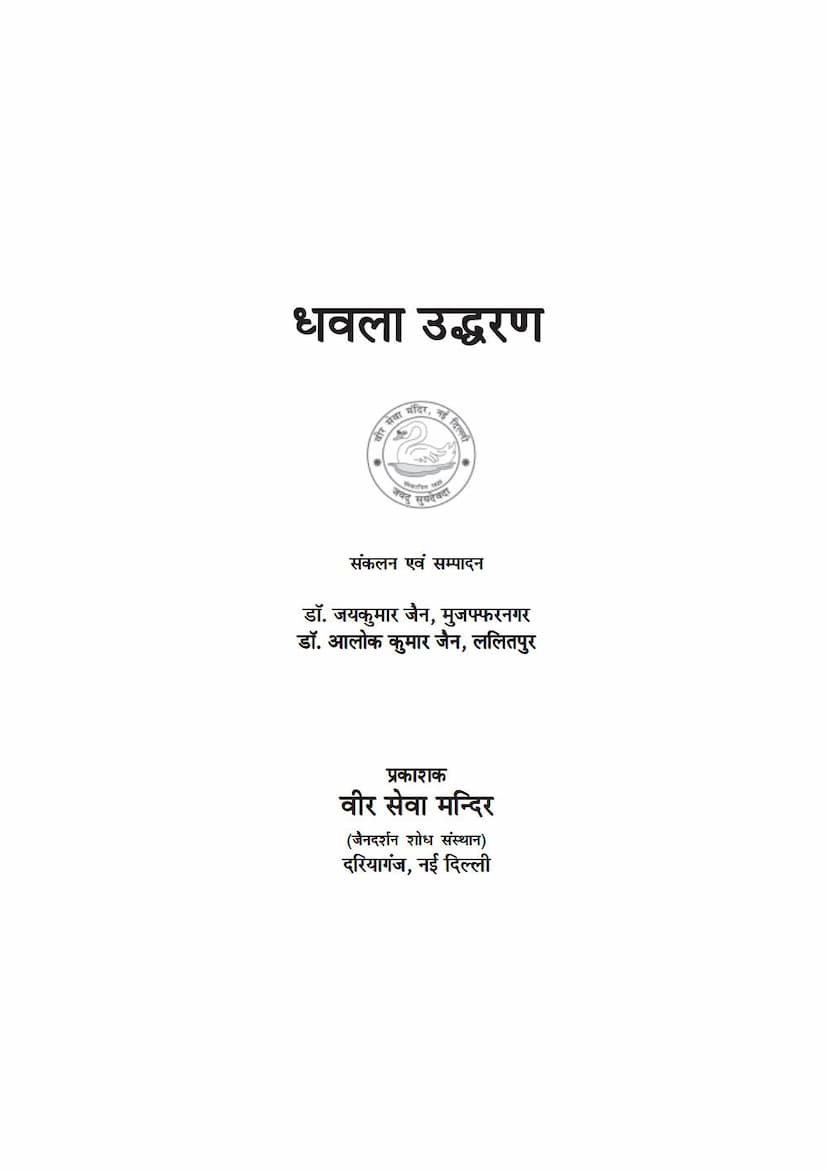Dhavala Uddharan
Added to library: September 1, 2025

Summary
The book "Dhavala Uddharan" (धवला उद्धरण) is a compilation and editing of excerpts from the Dhavala commentary, a foundational Jain text. The title translates to "Dhavala Extracts" or "Dhavala Selections."
Here's a comprehensive summary based on the provided pages:
1. Origins and Significance of Dhavala:
- The book highlights the importance of the Dhavala commentary, which was written by Acharya Virasena in the 9th century CE.
- Dhavala is a commentary on the Shatkhandagama (छक्खंडागम), a key Jain scripture believed to have been compiled by Acharyas Pushpadanta and Bhutabali based on the teachings of Acharya Dharasena.
- The Shatkhandagama is divided into six parts: Jivathana, Khuddabandha, Bandha Samyuttavichaya, Vedana, Vargana, and Mahabandha.
- Viracharyas' Dhavala is a highly respected and authoritative work that clarifies complex Jain philosophical and spiritual principles.
- The compilation aims to present the essential verses and stanzas from the Dhavala commentary, preserving the original intent and teachings of the Acharyas.
2. Key Jain Concepts and Terminology Explained:
The extracted passages provide definitions and explanations of various fundamental Jain concepts, including:
- Shastra Vyakhyaan Paddhati (शास्त्रव्याख्यान की पद्धति - Method of Scriptural Explanation): The text outlines the traditional method of explaining scriptures, which involves addressing six points: Mangal (auspiciousness), Nimitta (cause), Hetu (reason), Pariman (quantity), Nama (name), and Kartar (author).
- Naya (नय - Standpoints/Approaches): It explains the concept of 'naya' in Jain logic, defining it as a viewpoint that helps understand reality by focusing on specific aspects. Key Nayas discussed are:
- Dravyaarthika Naya (द्रव्यार्थिक नय): The perspective that focuses on the substance or essence of things, emphasizing generality and non-change.
- Paryayaarthika Naya (पर्यायार्थिक नय): The perspective that focuses on the modes, qualities, or states of things, emphasizing change and specific characteristics.
- Other nayas like Naigama, Sangraha, Vyavahara, Rujusutra, Shabda, Samabhirudha, and Evam-bhuta are mentioned as branches or classifications of these two primary nayas.
- Niskshapa (निक्षेप - Classification/Categories): It describes the four types of niskshapa (Nama, Sthapana, Dravya, and Bhava) used for analyzing entities, emphasizing their importance for accurate understanding.
- Panch Parameshti (पंच परमेष्ठी - The Five Supreme Beings): The text details the characteristics of Arihant, Siddha, Acharya, Upadhyaya, and Sadhu.
- Karma: Various aspects of karma are discussed, including its bondage, the impact of kashayas (passions), and the fruit of karma.
- Leshya (लेश्या - Karmic Dispositions): The six leshyas (Krishna, Neela, Kapota, Peeta, Padma, Shukla) are described with their associated characteristics and colors, explaining how they influence a being's experiences and actions.
- Knowledge and Perception: Different types of knowledge (Mati, Shruta, Avadhi, Manahparyaya, Kevala) and perception (Chakshu, Achakshu, Avadhi, Kevala) are discussed.
- Soul (Jiva - जीव): The text describes the soul's nature, its attributes, and its various classifications (e.g., by senses, karma, states of existence).
- Matter (Pudgala - पुद्गल): The nature of matter, its transformations, and its role in the Jain cosmology are touched upon.
- Other Important Concepts: The text also touches upon concepts like Ayushkarma (lifespan), the importance of Mangal (auspicious beginnings), the various stages of spiritual practice (Gunasthana), the significance of the Pancha Namaskara Mantra, and the workings of karma, including their bondage, influx (asrava), stoppage (samvara), shedding (nirjara), and eventual liberation (moksha).
3. Structure and Content:
The book appears to be organized by Dhavala books or sections. The content covers a wide range of topics, including:
- Philosophical Discussions: Detailed explanations of naya, niskshapa, and the nature of reality from a Jain perspective.
- Cosmology: Descriptions of the structure of the universe, the dwelling places of different beings (hell dwellers, humans, celestial beings), and the quantification of time and space.
- Biography and History: Brief mentions of important figures like Tirthankara Mahavira, Ganadhara Indrabhuti, and Acharya Virasena, as well as the origins of the Jain tradition.
- Ethical and Behavioral Guidelines: Discussions on conduct, restraints, and practices related to Jain monasticism and lay life.
- Metaphysics: The nature of soul, matter, time, space, and other ontological categories.
- Mathematical and Astronomical Calculations: The text includes intricate calculations related to time, space, and the quantities of beings, characteristic of Jain cosmology and philosophy.
4. Editorial and Publishing Information:
- Editors: Dr. Jaikumar Jain (Muzaffarnagar) and Dr. Alok Kumar Jain (Lalitpur).
- Publisher: Veer Seva Mandir (Jain Darshan Shodh Sansthan), New Delhi.
- First Edition: July 2016.
- Purpose: The compilation is intended for students and scholars to understand Jain philosophical subjects as expounded by the Dhavala commentator. The motivation is to preserve the accurate meaning of the sacred texts and guide against misinterpretations.
In essence, "Dhavala Uddharan" serves as an accessible gateway to the profound teachings contained within the Dhavala commentary, offering a structured and curated selection of verses to aid in the study and comprehension of Jain philosophy.